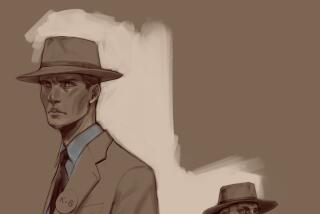In ‘Iron Man,’ he’s the heavy
- Share via
Creature effects supervisor Shane Mahan modestly credits much of his success to being in the right place at the right time. Born and raised in Greenville, Mich., population 3,000, the 44-year-old spent his childhood watching horror films, making Super-8 shorts about Dracula and Frankenstein and writing and directing plays.
“I think what it boils down to is the abject boredom of living out in the country [spurs] little kids to create these fun things to do,” he says.
As soon as he graduated from high school in 1981, Mahan headed to Hollywood. After a few internships, he landed his first job when Stan Winston Studio was crewing up for “The Terminator” in 1983. He’s worked there ever since.
Most recently, Mahan tested his mettle building the suits for “Iron Man,” due in theaters Friday, closely adhering to the designs by comic book artist Adi Granov and illustrator Phil Saunders.
Larger than life: In comic books, many characters are drawn to “heroic” proportions, and Mahan wanted to capture that larger-than-life essence. “We concentrated on making sure that the proportions of the body felt like classic Marvel comic book action heroes,” Mahan says. “The shoulders are broad, the legs are very long, the hips are narrow, and the head is small to give it the appearance of an illustration. And then we had to go through the process of finding stuntmen to fit inside of it. We had a lengthy audition process, searching for the right guy that has the longest legs and the thinnest hips and the broadest shoulders.”
Heavy lifting: While Mahan strove to make the suits as light as possible, the prototype Mark I suit and the iconic red and gold Mark III suit were, in essence, armor, weighing roughly 40 and 90 pounds, respectively. “You try to distribute [the weight] and, in between shots, you definitely keep people comfortable. We had suspension rigs that we could hook them to that was almost like an engine hoist that would take the weight off of their backs.”
Bright eyes: The suit’s eyes severely limited the wearer’s vision. “The eyes are very intense lights,” says Mahan. “So the challenge was to have these very bright lights right over an actor’s eyes -- how does he see around or under those? We ended up making just the simplest of things. In the black part around the eye, if you look at the design, there’s a little space underneath. And the back of the lights are so blacked out that they only project forward, so you couldn’t even see them when you were inside the helmet.”
If the suit fits: “Iron Man” star Robert Downey Jr. wasn’t cast until most of the suit design was already complete, so Mahan and his team retrofitted the costume to fit the actor. “In the end, I think that made it better. If you do it the traditional way where you get a person and you do a life cast or a scan and build directly on top of it, you get a certain look,” says Mahan. “This was building the machine, and then finding a way to fit the actor inside of it properly.
“There are always pluses and minuses to doing something that’s a little unorthodox like that, and the pluses were that it was, visually, a comic book illustration come to life. The minuses are, because it’s not a human proportion in a lot of ways, movement gets restricted. For the most part, it’s hard shells. You’re squeezing guys in, because it’s not a rubber suit like Batman. Iron Man has to replicate what should be about 600 or 700 pounds of steel suit. Superman, he’s so lucky in a blue spandex suit!”


